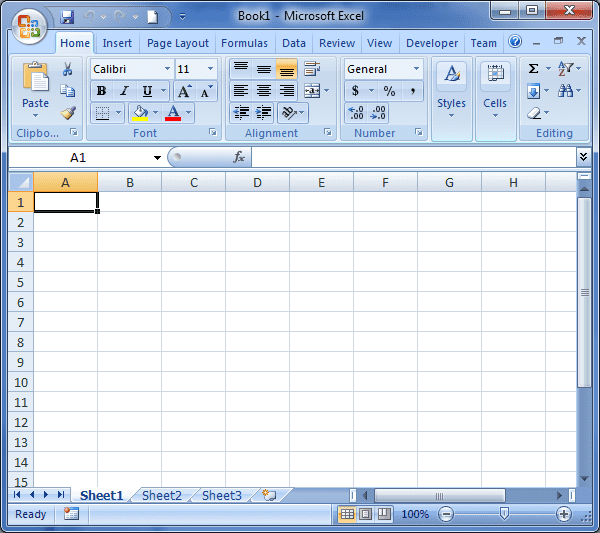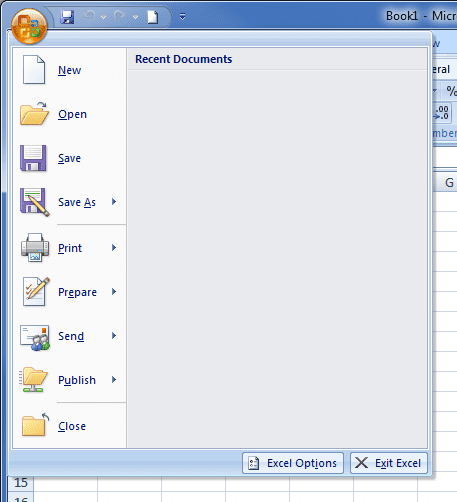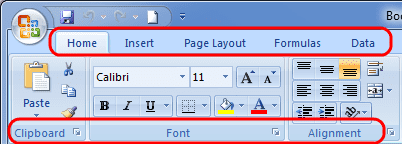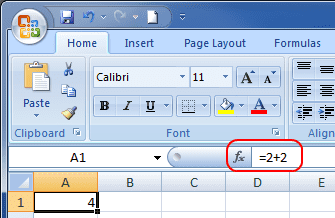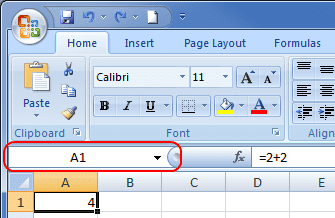An Introduction to Microsoft Excel 2007
April 11, 2012
What is Microsoft Excel?
Basically, it’s a spreadsheet program used to store, organize, and analyze data. But it’s much more than that. Excel has been around for a very long time (since 1982!) and since its inception tons of features have been added that help people create reports, charts, automate tasks, and much more.
So what does it look like?
Here is the main window of Excel 2007 when started. If you’re coming from Excel 2003 or earlier, you’ll notice some big changes (more on that later):
There are many components to what you see here. For simplicity, let’s break it up into five sections:
- Workbooks and Worksheets
- Quick Access Toolbar
- The Ribbon
- Formula Bar
- Name Box
Workbooks and Worksheets
In Excel, Worksheets are kind of like sheets of paper in a notebook with graph paper. Each worksheet has its own grid full of “Cells.” A Cell is a container for data and each little rectangle you see in the worksheet is a cell. Cells are organized by columns (A, B, C, …) and rows (1, 2, 3, …). They can hold plain text, or calculate data with formulas (more on formulas later).
Tip: A collection of cells is called a Cell Range.
A notebook would just be loose leaf paper if it weren’t bound together somehow. So just like a notebook, worksheets are kept together by Workbooks. A workbook is a collection of worksheets. That’s it.
Quick Access Toolbar
The Quick Access Toolbar lets you add commands that are always visible to you while working with the Workbook. Commonly found commands are Save, Undo, Redo, and the New Workbook commands.
Also, if you’re looking for the “File” button, there is none. However, you can use the new Office Button as shown below.
The Ribbon
If you’re coming from Excel 2003 or previous, you’ll immediately notice that the toolbar is gone. It has been changed for what is now called “The Ribbon,” which organizes common commands into “groups” and further organizes them into “tabs.” The tabs are found at the top of the Ribbon such as the Home, Insert, and Page Layout tabs.
The groups are found at the bottom of each tab. So for the Home tab, you’ll find the Clipboard group, Font group, etc. Within each group are commands associated with the group name. So for the Clipboard group you have the Cut, Copy, and Paste commands. Also, if you look closely at some of the group names, you’ll see a small icon to the right of their name. Clicking this will open advanced options for the group.
Tip: Double-clicking the active tab toggles the Ribbon on and off.
If you feel the Ribbon is in your way, you can double-click the active tab (the tab that is highlighted) and it will minimize the Ribbon. You can display the Ribbon temporarily by clicking any tab once while minimized. To get the Ribbon back to full size, double-click any tab once more. And for those of you who love keyboard shortcuts, you can use CTRL+F1.
That’s pretty much it for the Ribbon. There are ways to customize and enhance it, but those are more advanced topics and we’re keeping things simple in this post.
Formula Bar
The Formula Bar is an area to display a cell’s data. If the cell uses a formula, it will display the formula; if not, it will show the value. Take a look at the image below. The cell A1 is selected, but the formula bar shows a formula.
Also, the little “fx” icon to the left of the Formula Bar is actually a button that will open up an “Insert Function” window. This window allows you to easily insert simple formulas into the Formula Bar. We’ll talk more about formulas in a later post and I’m sure we’ll dig into more complex formulas in due time.
Name Box
Finally, we come to the Name Box. Located just to the left of the Formula Bar, the Name Box displays a reference to the selected cell (in the image below, it states “A1”). The Name Box will also display a “Named Range” if a cell range was given a name. The little arrow to the right will display all Named Ranges in the current workbook which, when selected, will highlight the cells in the Named Range.
Wrap Up
That pretty much covers the very basics of Excel 2007. If you enjoyed the content, please subscribe for more posts about how to create formulas, make charts, and more.
